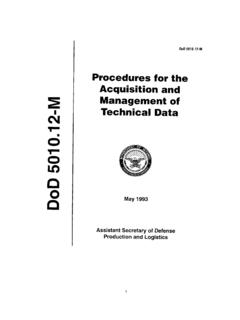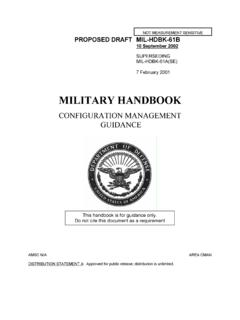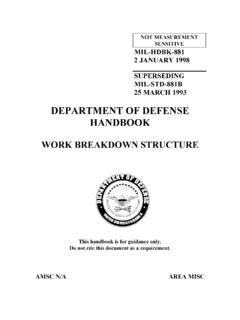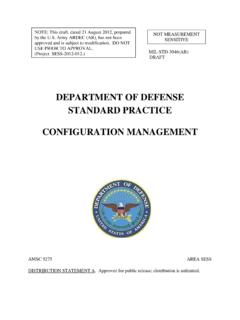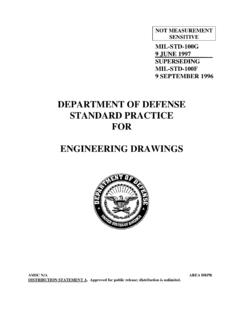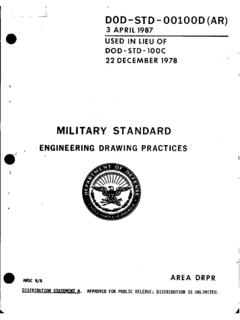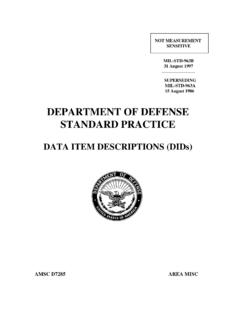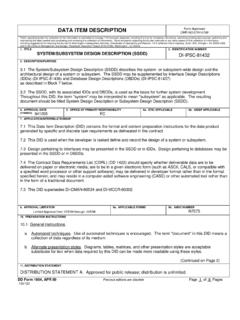Transcription of DEPARTMENT OF DEFENSE HANDBOOK - Product …
1 NOT MEASUREMENTSENSITIVEMIL-HDBK-8812 JANUARY 1998 SUPERSEDINGMIL-STD-881B25 MARCH 1993 DEPARTMENT OF DEFENSEHANDBOOKWORK BREAKDOWN STRUCTUREThis HANDBOOK is for guidance not cite this document as a N/A AREA MISCMIL-HDBK-881iForeword1. This HANDBOOK is approved for use by all Departments and Agencies of the Departmentof This HANDBOOK is for guidance only. This HANDBOOK cannot be cited as a it is, the contractor does not have to A work breakdown structure (WBS) provides a consistent and visible framework fordefense materiel items and contracts within a program. This HANDBOOK offers uniformity indefinition and consistency of approach for developing the top three levels of the workbreakdown structure.
2 The benefit of uniformity in the generation of work breakdownstructures and their application to management practices will be realized in improvedcommunication throughout the acquisition This HANDBOOK addresses mandatory procedures for those programs subject to DODR egulation It also provides guidance to industry in extending contract workbreakdown This HANDBOOK is a conversion of MIL-STD-881B, Work Breakdown Structures forDefense Materiel Items, with no substantive changes in work breakdown structuredefinition. MIL-STD-881B was based on the cooperative efforts of the military services,with assistance from industrial Beneficial comments (recommendations, additions, deletions) and any pertinent datawhich may be of use in improving this document should be addressed to:OUSD(A&T)API/PM, 3020 DEFENSE PENTAGON, ROOM 3E1025,WASHINGTON, DC 20301-3020 by using the self-addressed Standardization DocumentImprovement Proposal (DOD Form 1426) appearing at the end of this document or vChapter 1 General HANDBOOK Purpose and Support Intended Use of What Does A Work Breakdown Structure Accomplish?
3 How is the WBS Related to Other Contract Requirements?.. WBS 2 Program Management Program WBS Preparing a Program Solicitation and Contract Statement of Request for Integrated Cost, Schedule, and Technical Performance 3 Contractor Developing the Contract Contractual 4 Post Contract Implementation of Contract Work Breakdown Specification of Basis for Scheduling 1-1: System Life 1-2: WBS 2-1: Functional Requirements in the Concept Exploration 2-2: Identification of Major Subsystems and Configuration 2-3: Program WBS 2-4: Work Breakdown Structure Matrix (Contract WBS)..14 Figure 3-1: Relationship of Program WBS with Contract 3-2: Relationship of Contract WBS to Subcontract 3-3: Translation from Function to 3-4: IPT Intersection with Contract 3-5: Linkage Between Contractor WBS and Contractor Management 3-6: Example of Software Intensive System 3-7: Integrated Management Plan and Integrated Management A: Aircraft Systems Work Breakdown Structure and B: Electronic/Automated Software Systems Work Breakdown Structure C: Missile Systems Work Breakdown Structure and D: Ordnance Systems Work Breakdown Structure and E: Ship Systems Work Breakdown Structure and F: Space Systems Work Breakdown Structure and G: Surface Vehicle Systems Work Breakdown Structure and H.
4 Common Elements Work Breakdown Structure and CategoryCARDCost Analysis Requirements DescriptionCCDRC ontractor Cost Data ReportingCDRLC ontract Data Requirements ListCPRCost Performance ReportsCFSRC ontract Funds Status ReportsCLINC ontract Line Item NumberCSCIC omputer Software Configuration ItemC/SSRCost/Schedule Status ReportsESWBSE xtended Ship Work Breakdown StructureEVMSE arned Value Management SystemMIL-STDM ilitary StandardR&DResearch and DevelopmentRFPR equest for ProposalSOWS tatement of WorkWBSWork Breakdown StructureMIL-HDBK-881vi(THIS PAGE LEFT INTENTIONALLY BLANK)MIL-HDBK-8811 CHAPTER 1:GENERAL HANDBOOK PURPOSE AND STRUCTUREThis HANDBOOK presents guidelines for preparing, understanding, and presenting awork breakdown structure (WBS).
5 After the general purpose of work breakdownstructures is discussed in Chapter 1, the HANDBOOK provides instructions on how todevelop a program work breakdown structure (Program WBS) in Chapter 3 offers guidance for developing and implementing a contract workbreakdown structure (Contract WBS). Chapter 4 examines the role of the workbreakdown structure in contract negotiation and award and in post-contractperformance. The appendices present definitions of work breakdown structures forspecific applications. The HANDBOOK s primary objective is to achieve a consistentapplication of the work breakdown structure. The information it contains isintended to provide guidance to contractors and direction to government SUPPORT DOCUMENTATIONThe foundation for work breakdown structures is contained in DoD and DoD Regulation These documents identify responsibilities inthe acquisition process from the Office of the Secretary of DEFENSE to theDepartment of DEFENSE (DoD) component field activities.
6 Preparing a workbreakdown structure is generally discussed in the context of planning andmonitoring a DEFENSE materiel system INTENDED USE OF HANDBOOKThis HANDBOOK is directed primarily at the preparation of a work breakdownstructure for a DEFENSE materiel item. This includes all materiel items or majormodifications established as an integral program element of the Future YearsDefense Program or otherwise designated by the DoD component or the UnderSecretary of DEFENSE (Acquisition and Technology).The guidance is appropriate for use with any work breakdown structure developedat any phase Concept Exploration, Program Definition and Risk Reduction,Engineering and Manufacturing Development, or Production during theacquisition HANDBOOK clearly delineates the overlapping responsibilities of DoD programmanagers and contractors relative to work breakdown WHAT DOES A WORK BREAKDOWN STRUCTUREACCOMPLISH?
7 ApplicationsThis HANDBOOK addresses two fundamental and interrelated types of workbreakdown structures the Program WBS and the Contract WBS. The ProgramWBS provides a framework for specifying the objectives of the program. It definesthe program in terms of hierarchically related Product -oriented elements. Eachelement provides logical summary points for assessing technical accomplishmentsand for measuring cost and schedule Contract WBS is the government-approved work breakdown structure forreporting purposes and its discretionary extension to lower levels by thecontractor, in accordance with government direction and the contract workstatement. It includes all the elements for the products (hardware, software, data,or services) which are the responsibility of the , the work breakdown structure serves as a coordinating medium.
8 Throughthe Program WBS and the Contract WBS, work is documented as resources areallocated and expended. Technical, schedule, and cost data are routinely generatedfor reporting purposes. The work breakdown structures summarize data forsuccessive levels of management and provide the appropriate information on theprojected, actual, and current status of the elements for which they are WBS keeps the program s status constantly visible so that the programmanager, in cooperation with the contractor, can identify and implement changesnecessary to assure desired BenefitsThe work breakdown structure assists in several ways during the life of a WBS: Separates a DEFENSE materiel item into its component parts, making therelationships of the parts clear and the relationship of the tasks to becompleted to each other and to the end Product clear.
9 Significantly affects planning and the assignment of management and technicalresponsibilities. Assists in tracking the status of engineering efforts, resource allocations, costestimates, expenditures, and cost and technical performance. Helps ensure that contractors are not unnecessarily constrained in meeting Challenges The primary challenge is to develop a work breakdown structure which defines thelogical relationship between all the elements of the program and its naturalextension with the contract. Defining the Contract WBS to the third level ofindenture does not constrain the contractor s ability to define or manage theprogram and resources. However, if the government considers elements of theprogram to be high cost or high risk, the system may be defined to a lower level ofthe WBS.
10 This is reasonable as long as the Product -oriented logical extension ismaintained. In any event the contractor should extend all other elements to thelevel and form that the contractor desires based on the way the system isdeveloped, produced, or managed. A second challenge is to balance the program definition aspects of the WBS withits data-generating aspects. Using available data to build historic files to aid in thefuture development of similar DEFENSE materiel items is a very valuable , however, that the primary purpose of the work breakdown structure isto define the program s structure, and the need for data should not distort orhinder the program definition. HOW IS THE WBS RELATED TO OTHER CONTRACTREQUIREMENTS? The work breakdown structure provides the basis for communication throughoutthe acquisition process.
